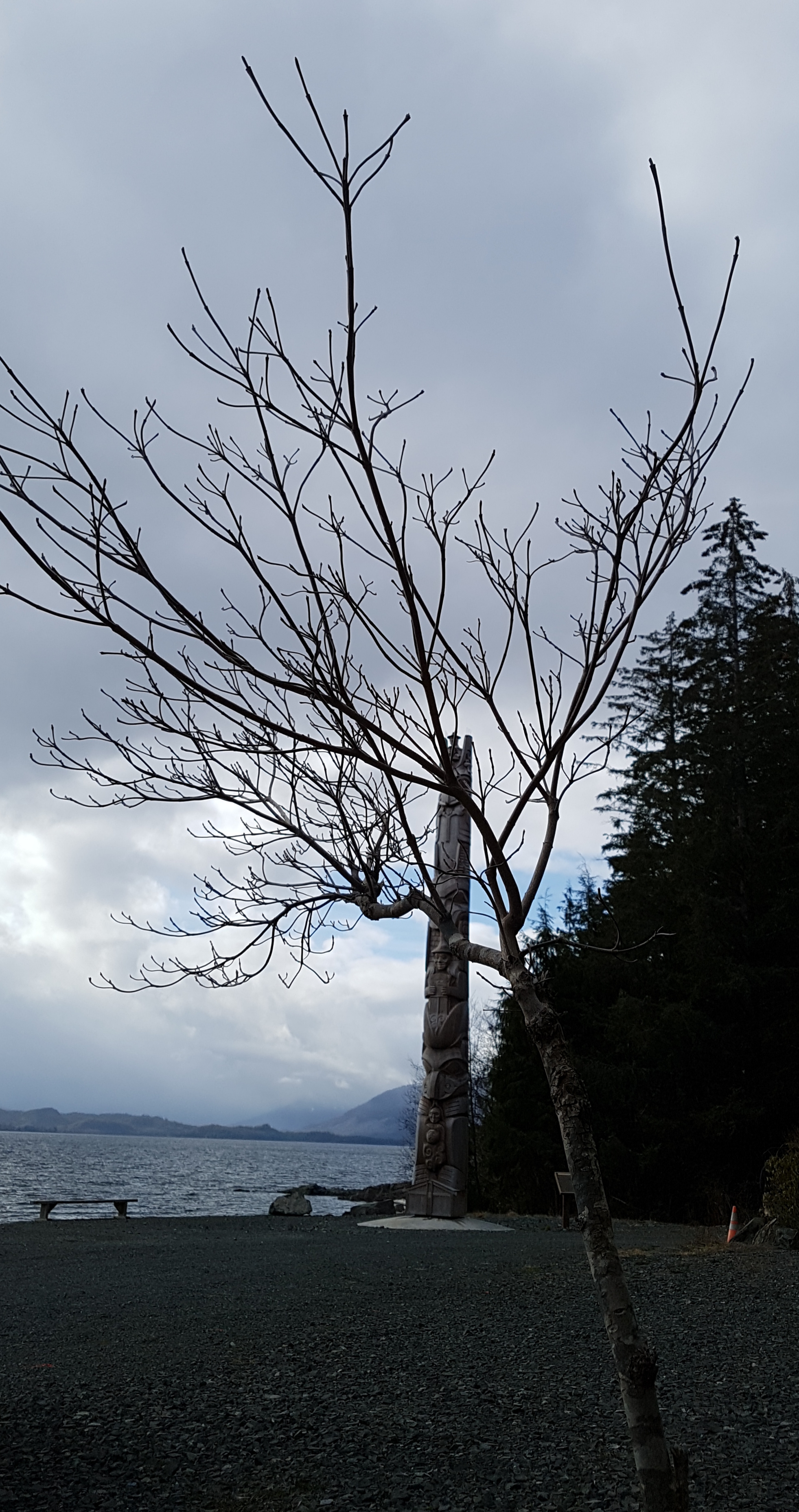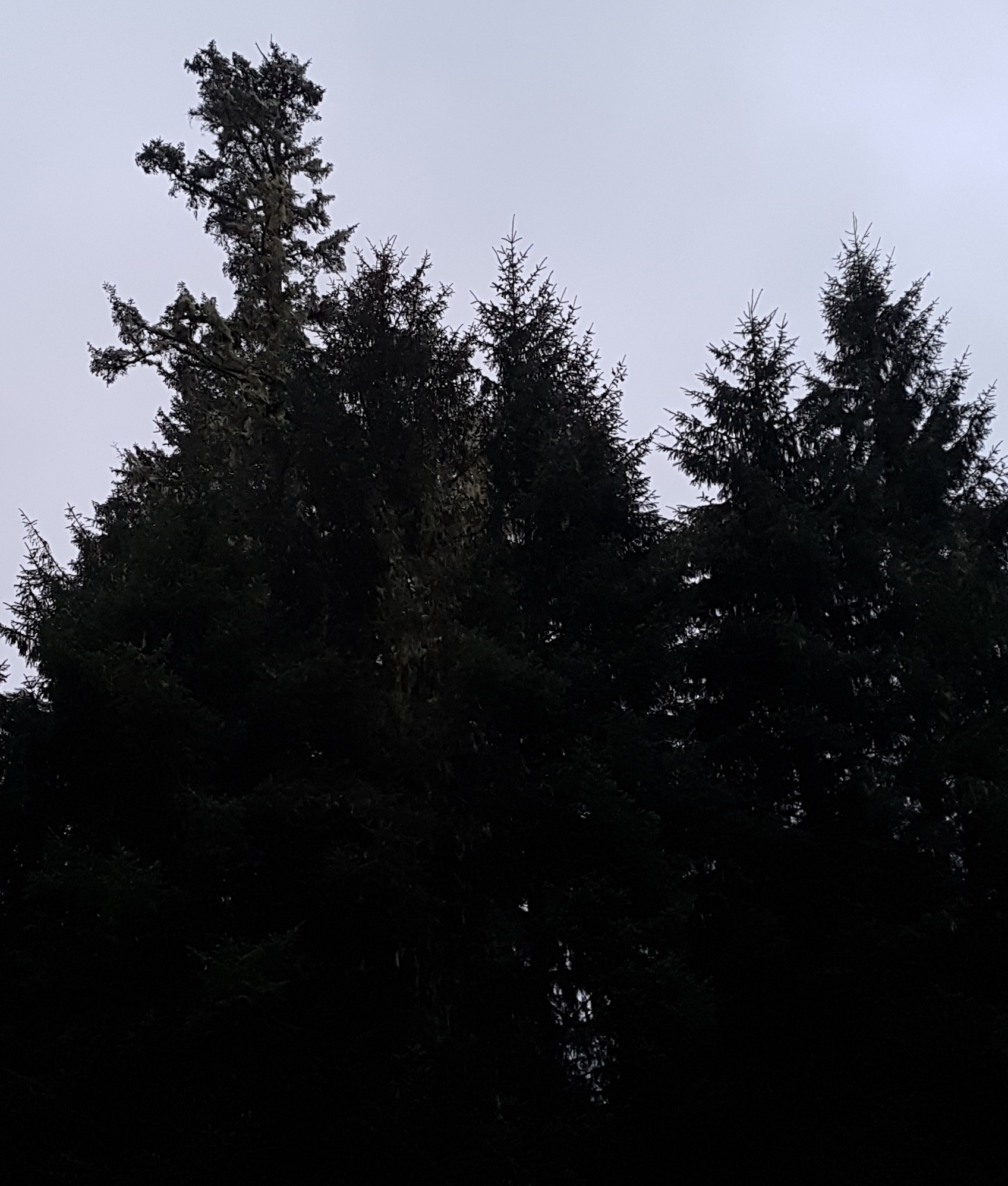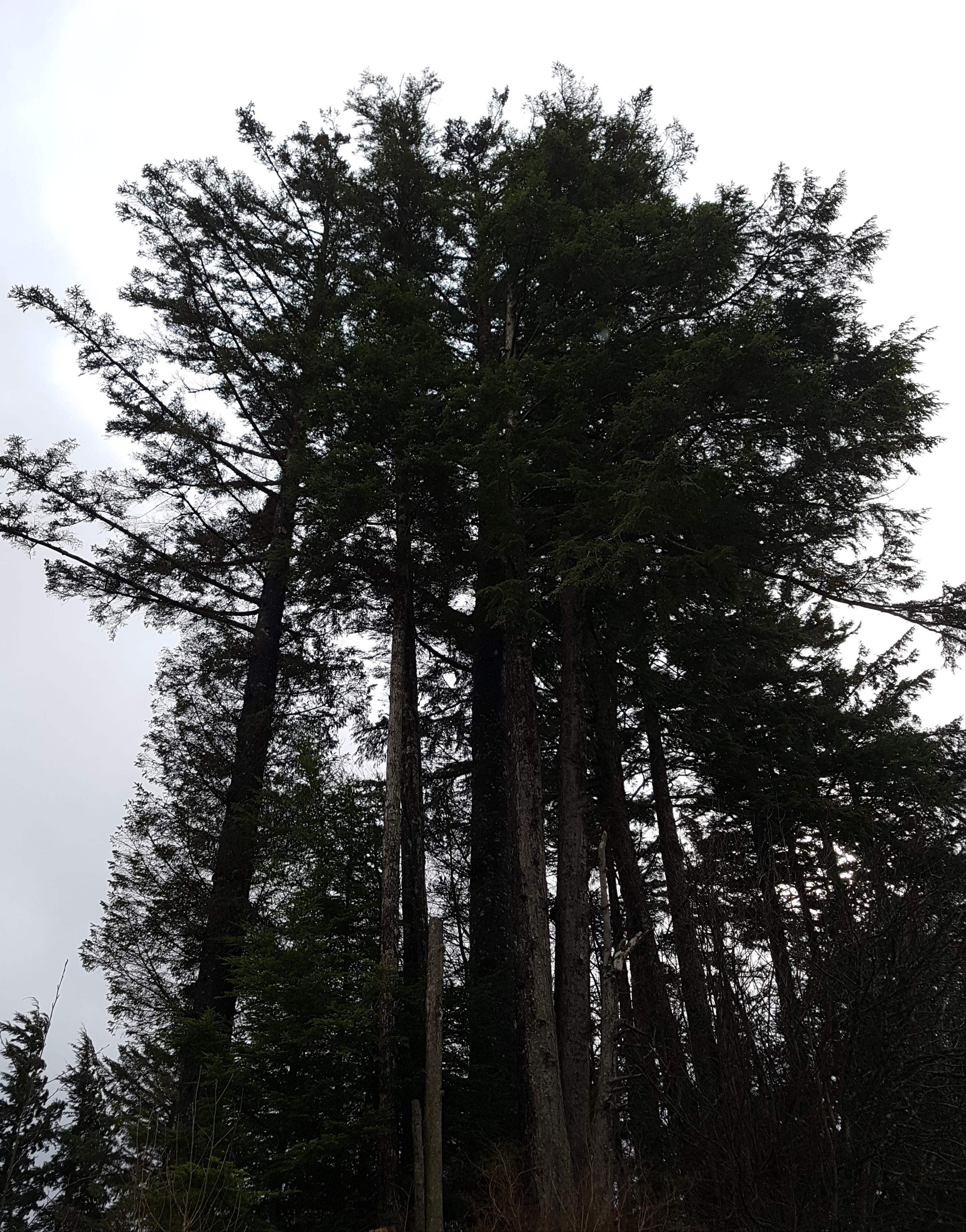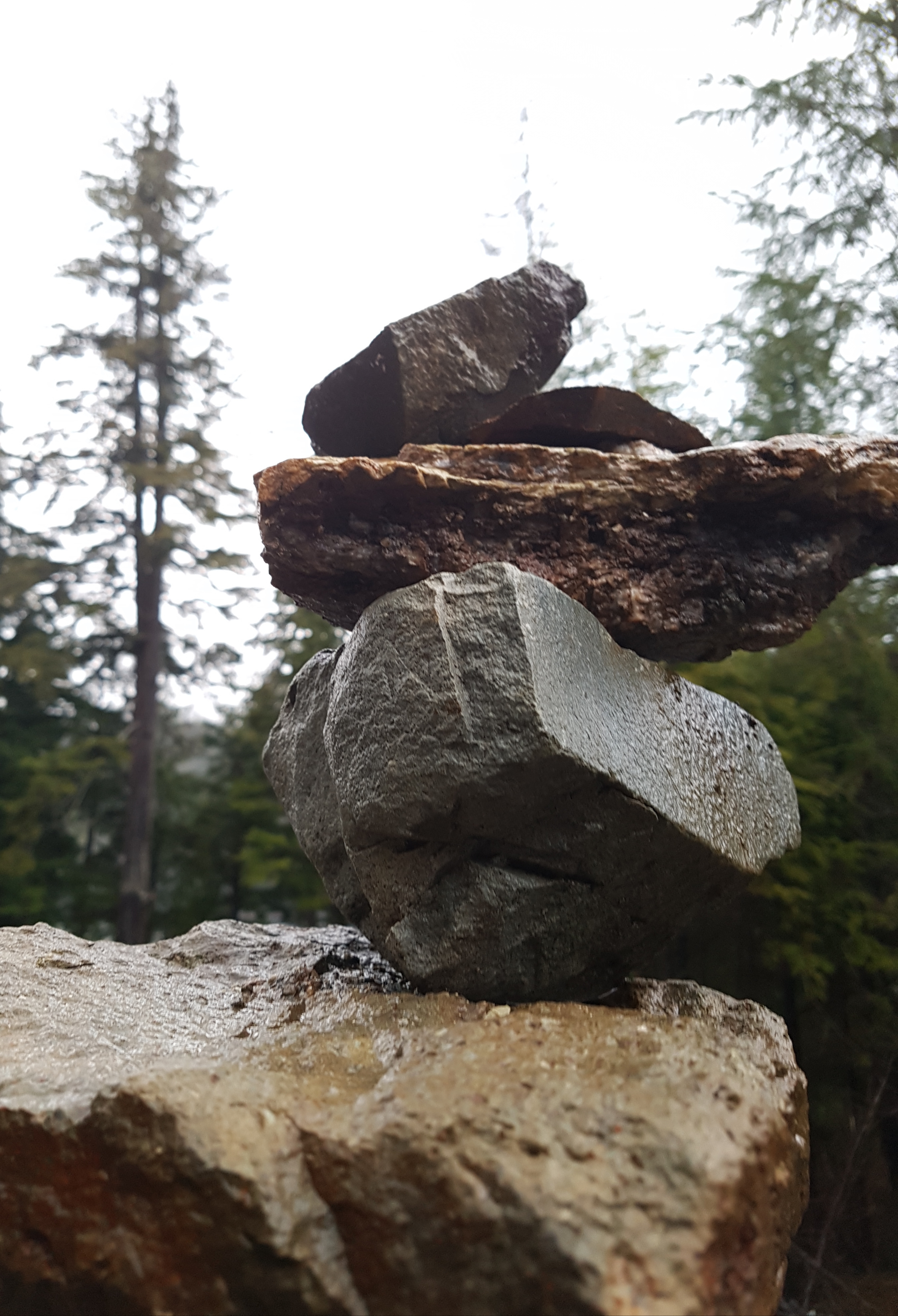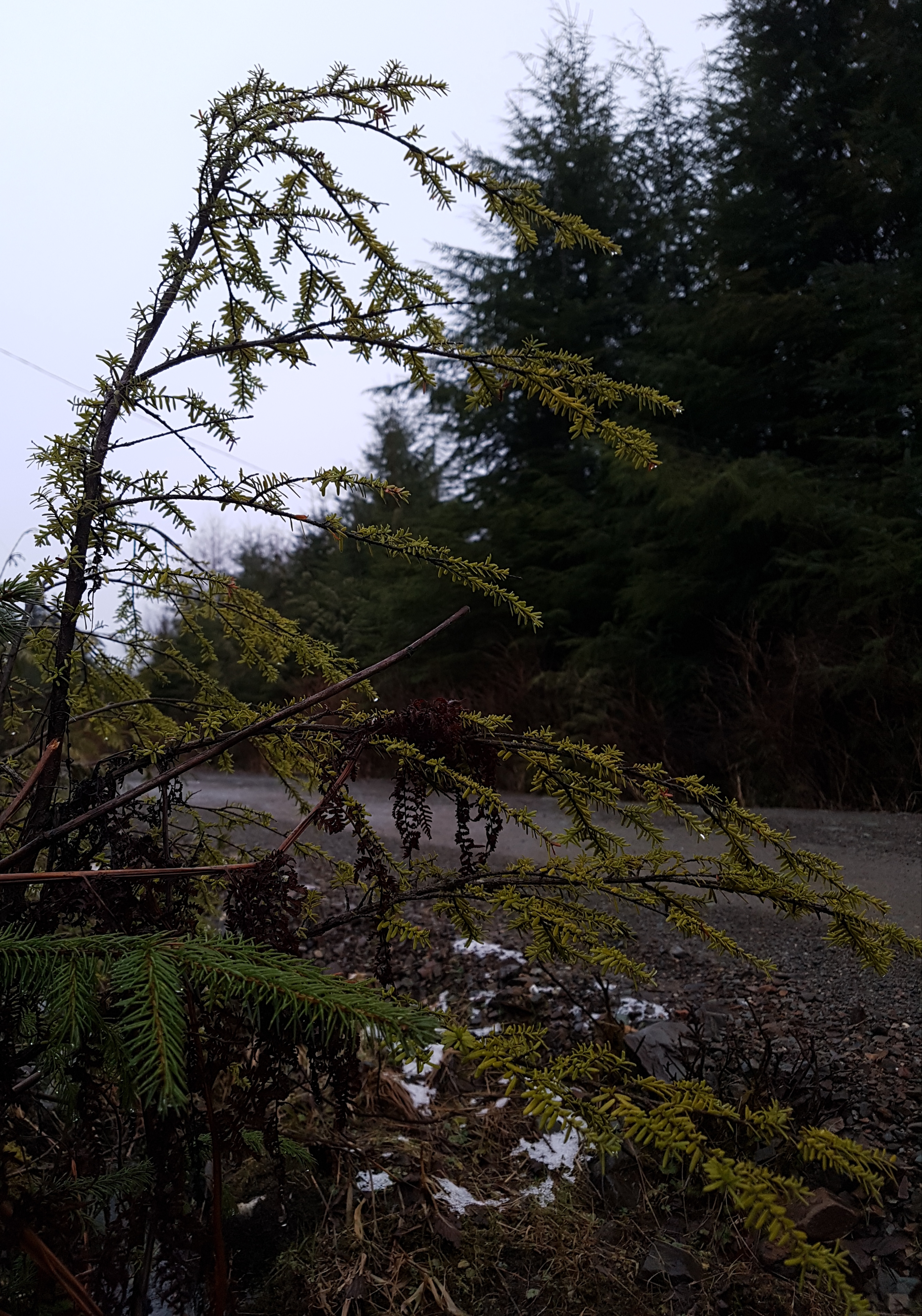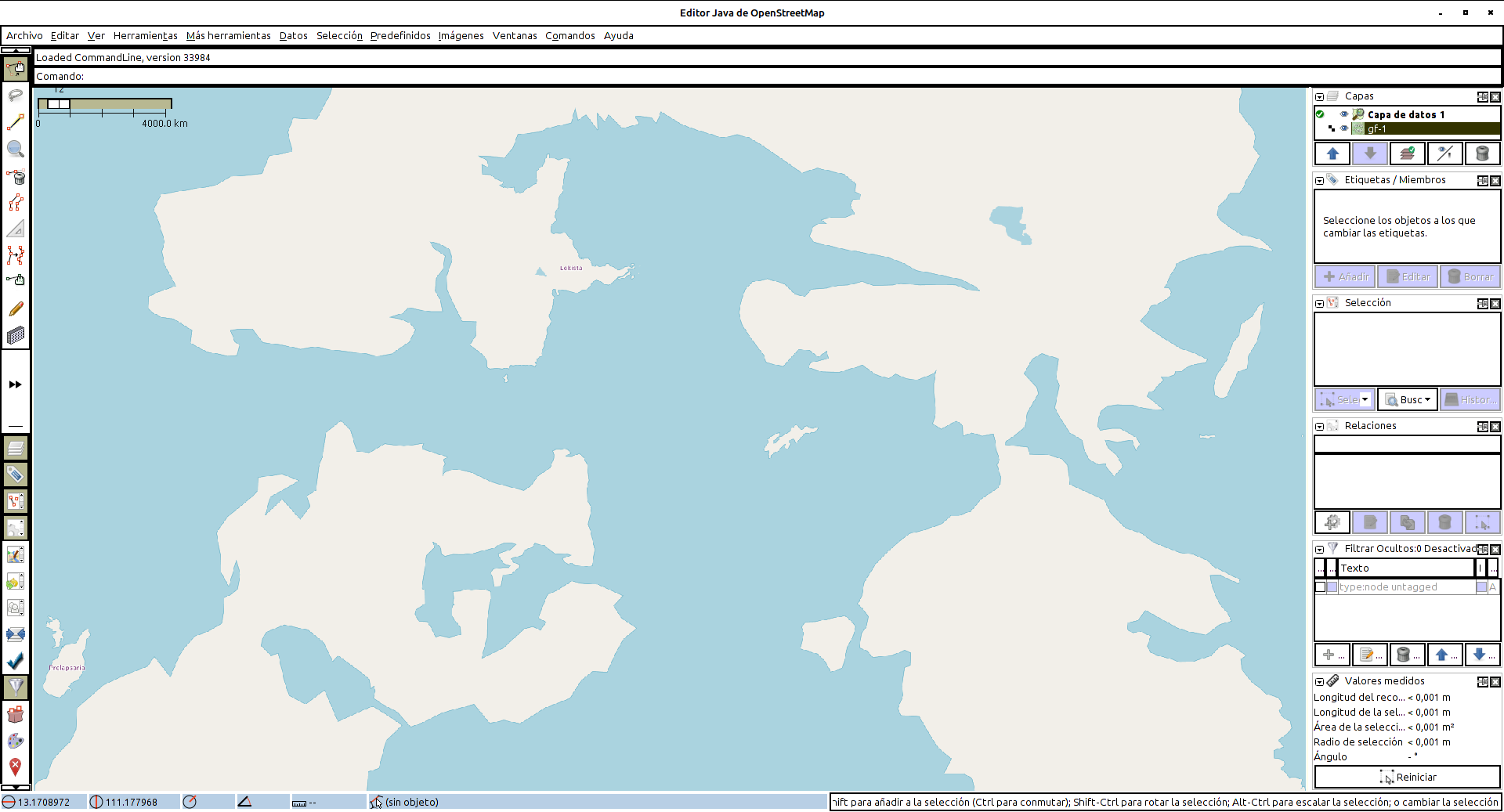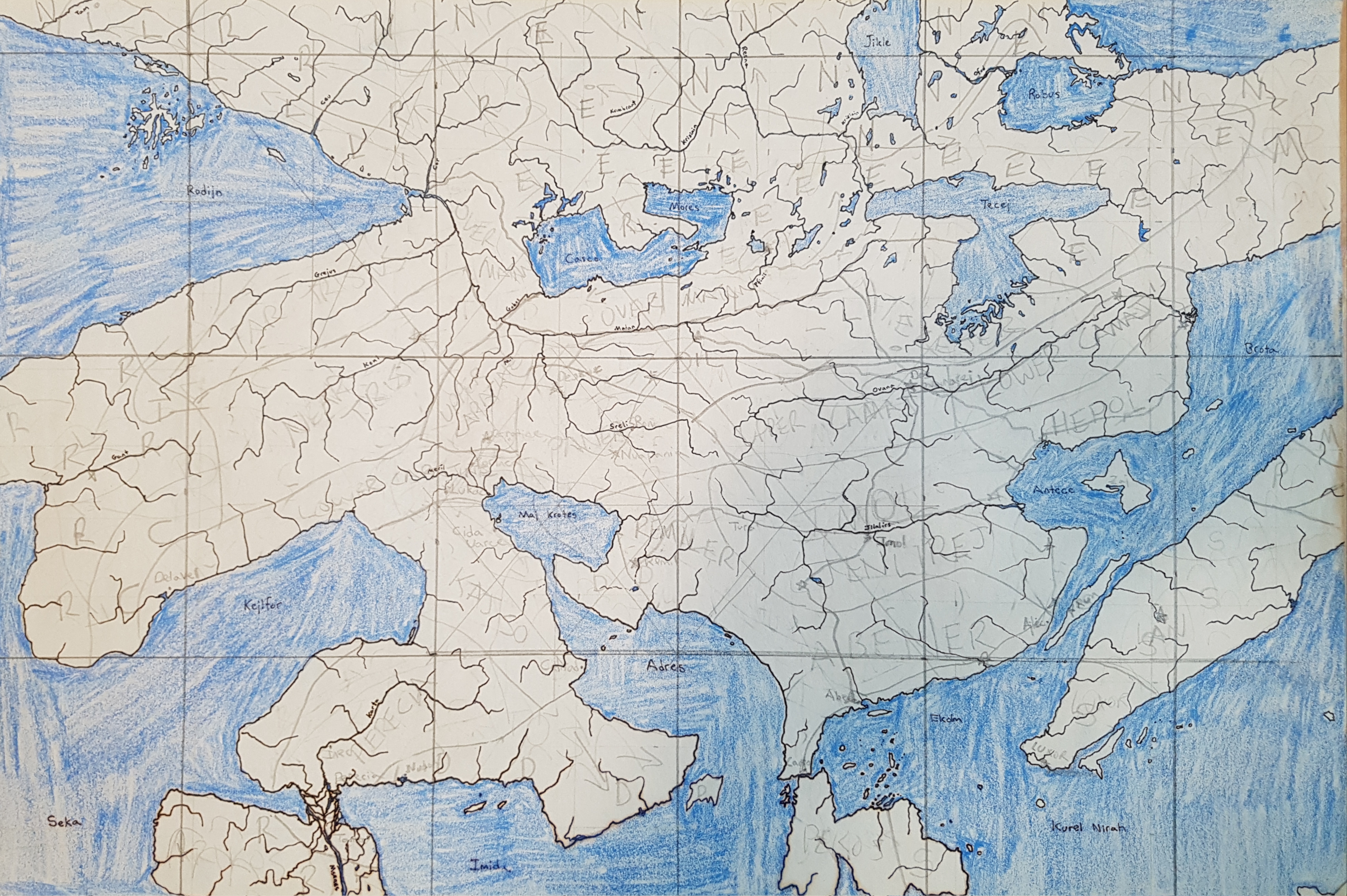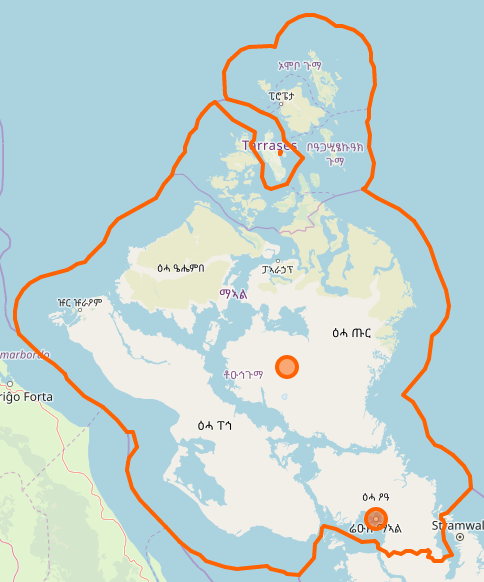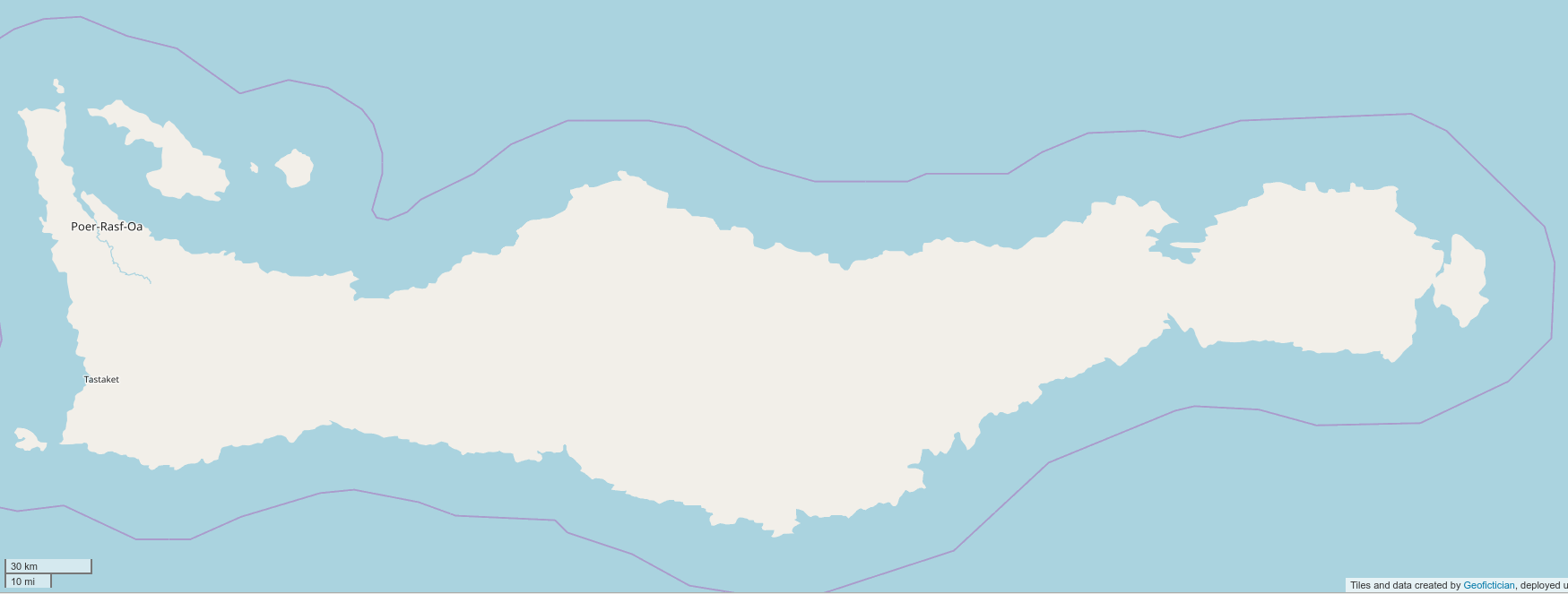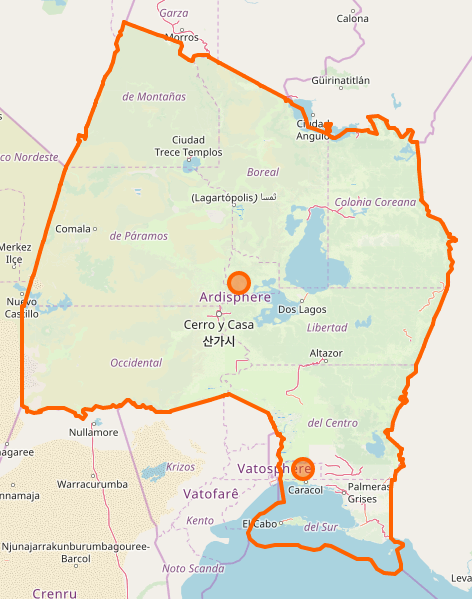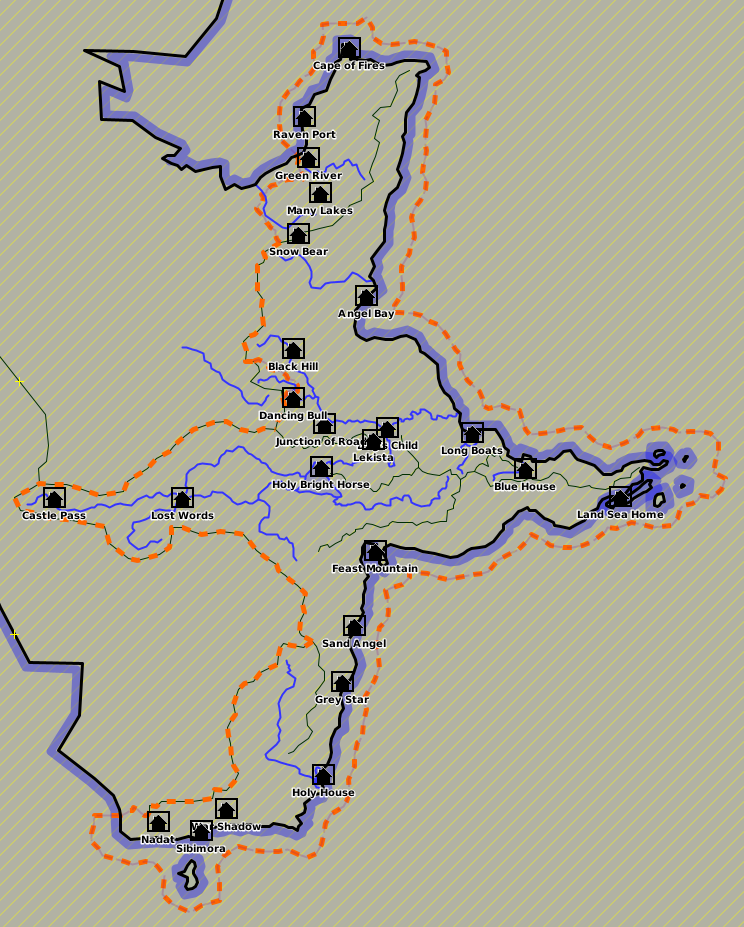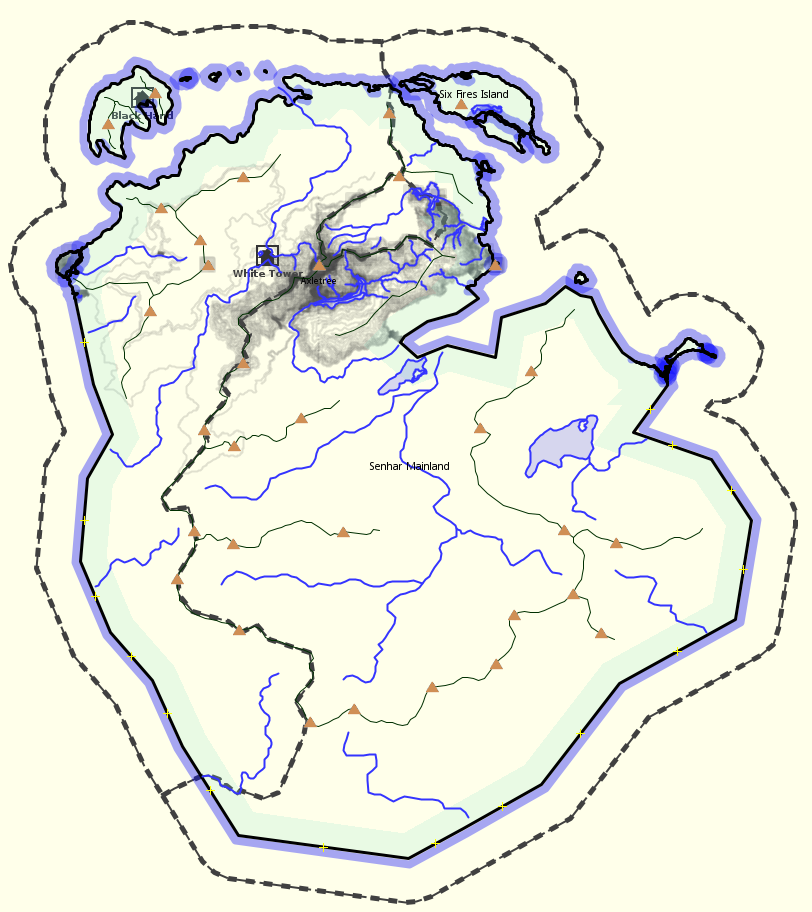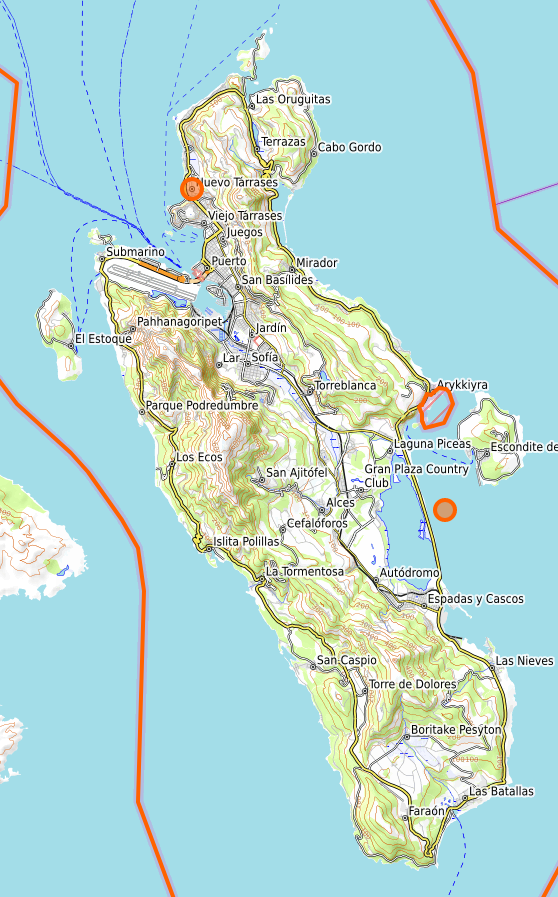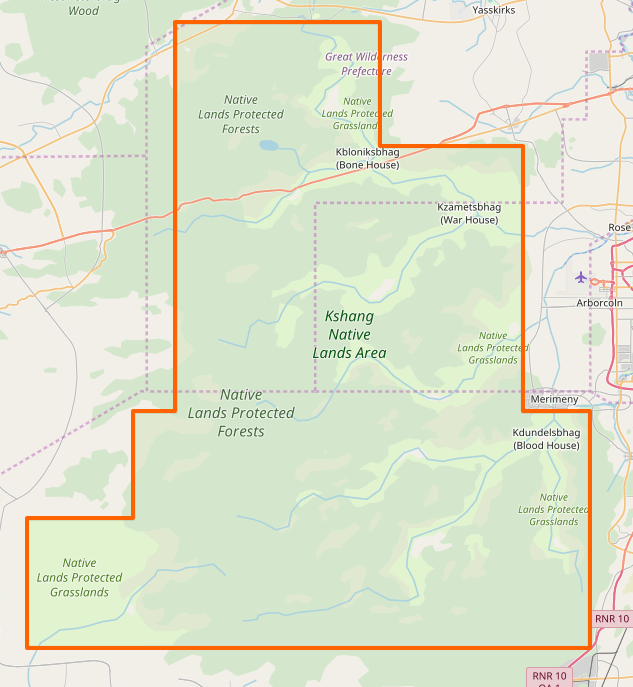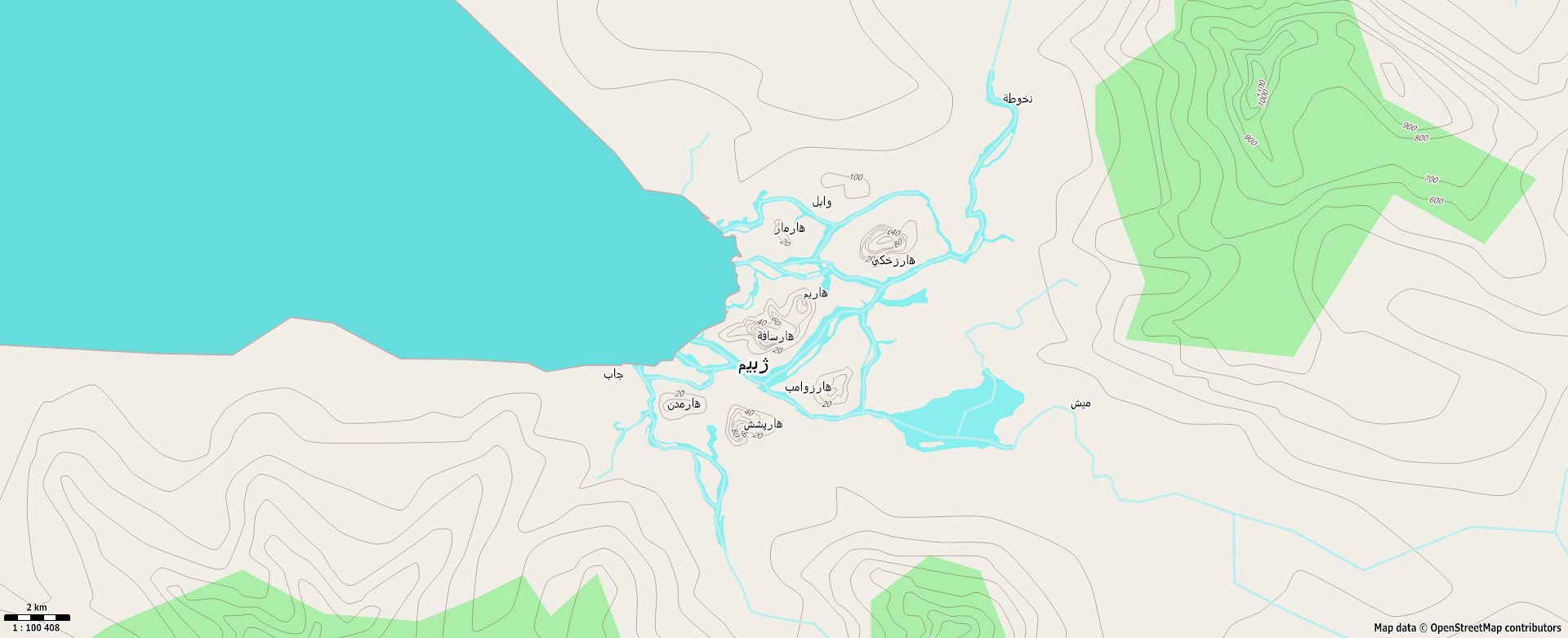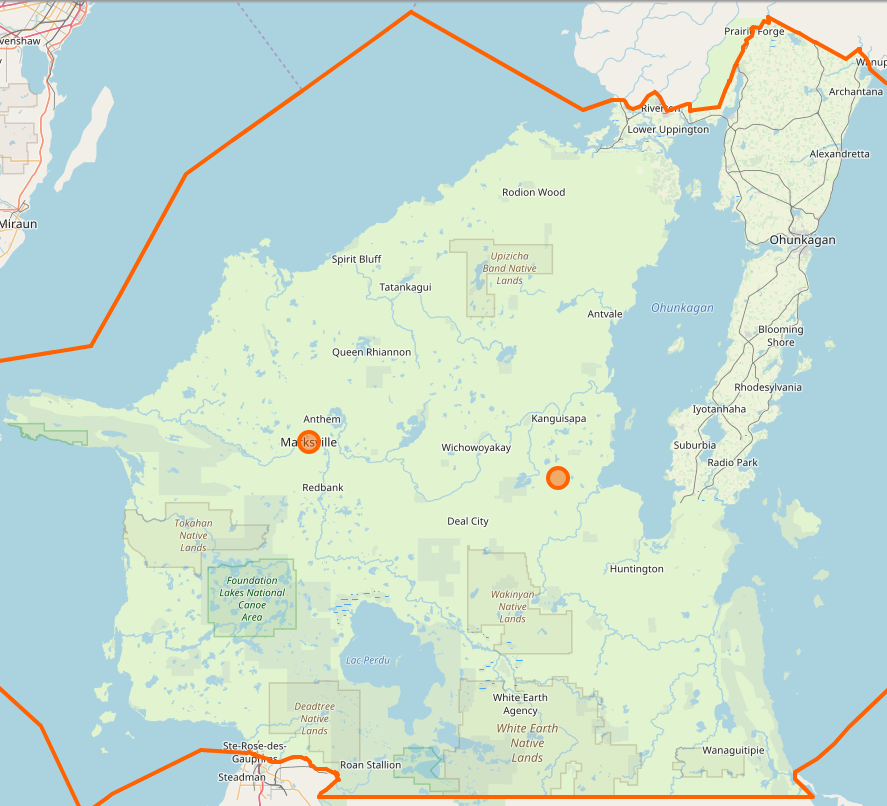Month: February 2020
Caveat: A beach day
My brother Andrew and I went to Kasaan. There is a totem pole park there – a kind of outdoor museum of native culture.
Kasaan is possibly my favorite place on the island. It being winter, the cafe and indoor visitor center was closed. But we walked among the totems, saw the old long house, and had a kind of impromptu picnic on the beach.
It was a nice day, though quite cold – I think about 36° F (2 C), and windy.
Here is Andrew on the rocky beach.
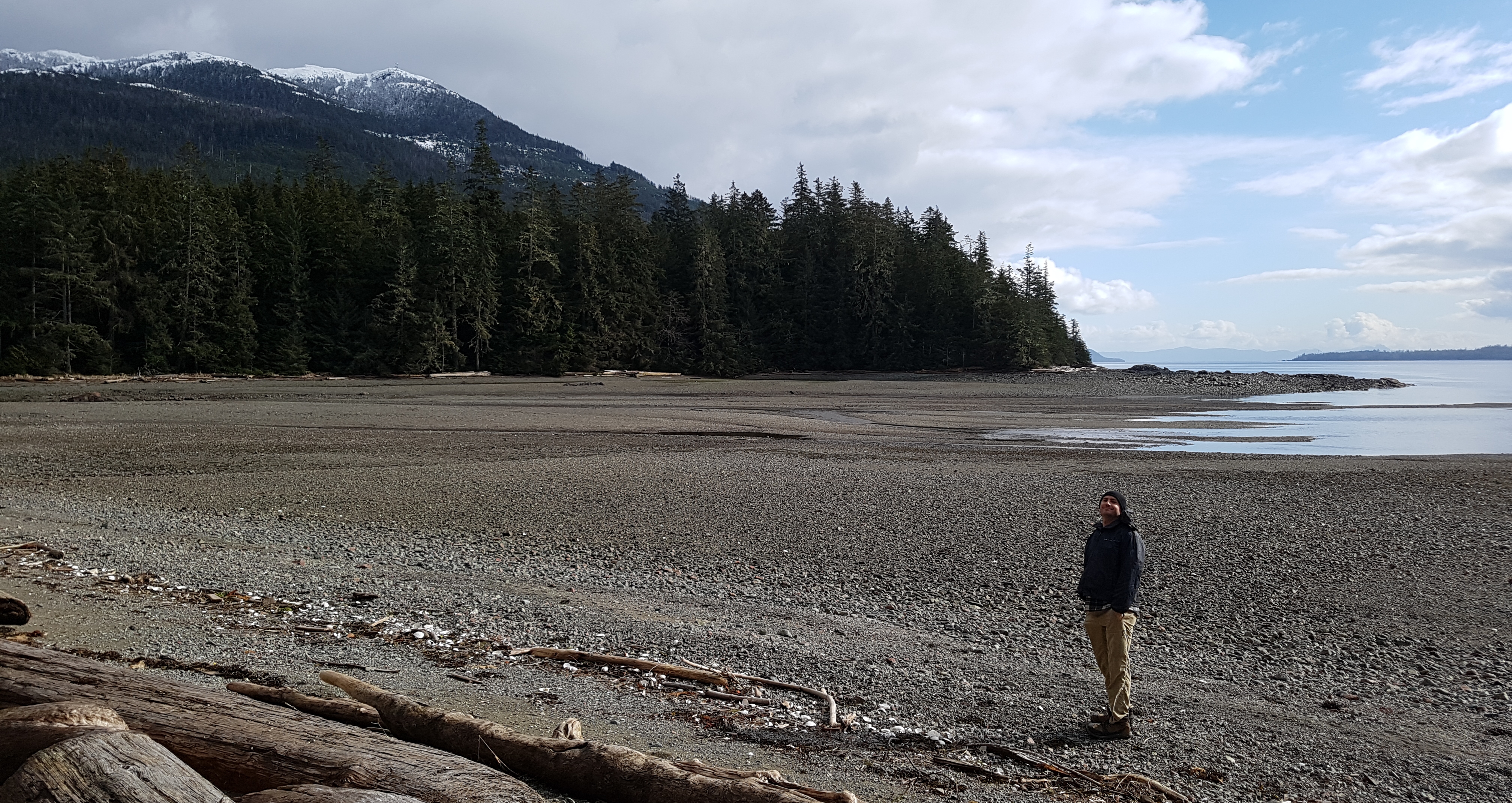
![]()
Caveat: Poem #1308 “A painting by Turner”
ㅁ A rainless dawn presents its colors, here, revealing whitecaps racing down the bay.
Caveat: Tree #422
Caveat: greenhouse rising
My brother Andrew is visiting. I have a certain project I’ve decided to ask his assistance with – he has a much wider Alaska-appropriate skillset than I do, and is able to build things.
I bought a kit greenhouse a while back, because I want to have a greenhouse, here. The main building issue with setting it up is that it needs a kind of “foundation” to rest on – not a full structural foundation, but at least something to anchor it to the ground. That’s what Andrew and I are working on.
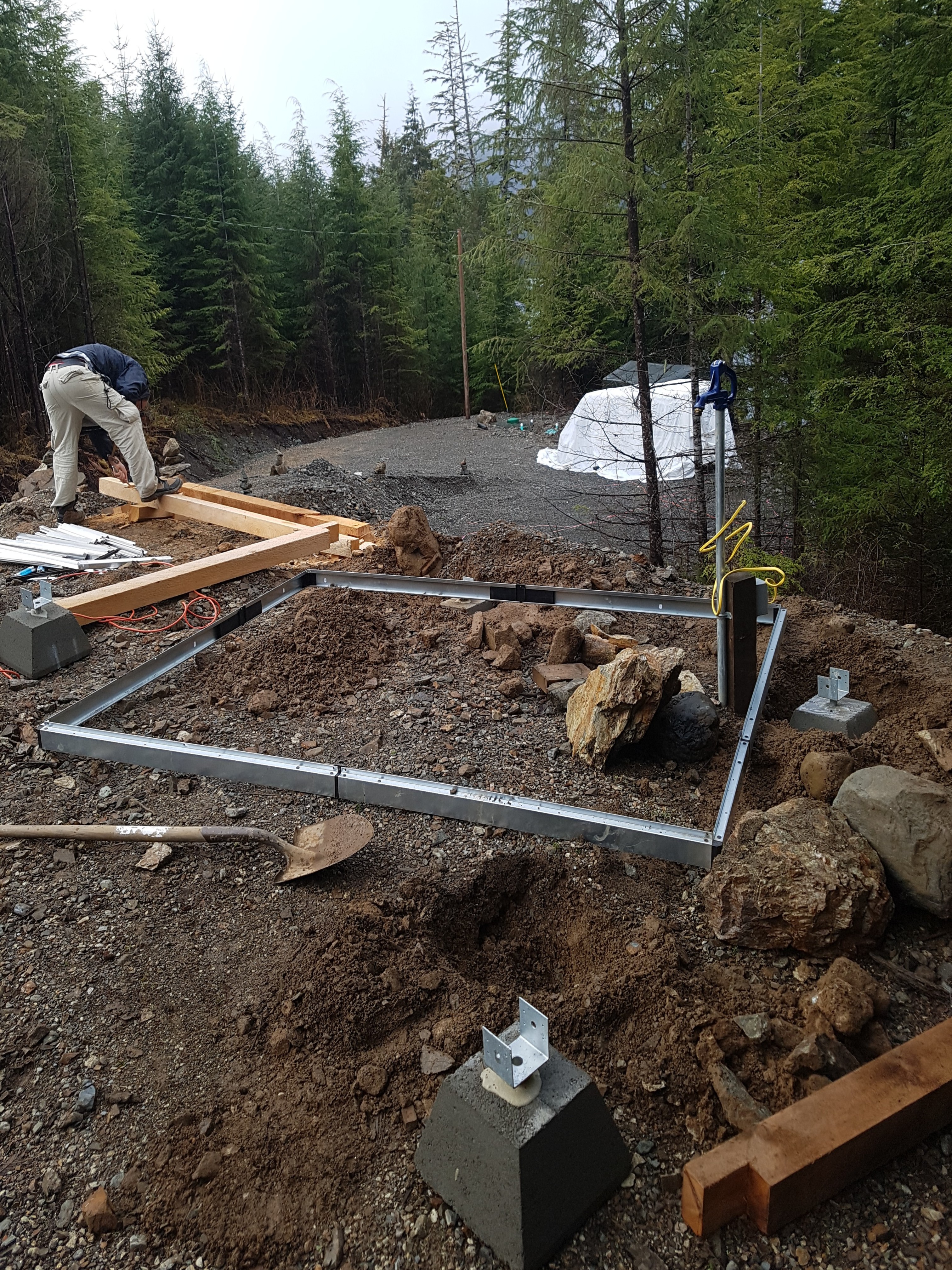
![]()
Caveat: Poem #1307 “Or cold coffee’s okay, too”
ㅁ My coffee's ready, waiting for me there. Now, can I not forget before it cools?
Caveat: Tree #421
Caveat: The storm like people
The Storm Like people emerging from a steambath, bending over, steaming from their heads and shoulders, the ring of the mountains from the Chilkat Range to the Juneau ice field as if in steambath towels of snow flurries; at their feet are foaming white caps of sea like water thrown on rocks steaming from the heat. - Nora Marks Dauenhauer (Tlingit poet, 1927-2017)
Caveat: Poem #1306 “The city as machine”
ㅁ The city's limbs were crafted stone and wood, extending out across the rolling plain. Thin vessels made of steel and copper wire assisted in connecting place to place.
Caveat: Tree #420
My brother Andrew has come to visit for about a week. So I went to the ferry terminal to pick him up. Inside the ferry terminal, I saw this tree, made out of a… tree.
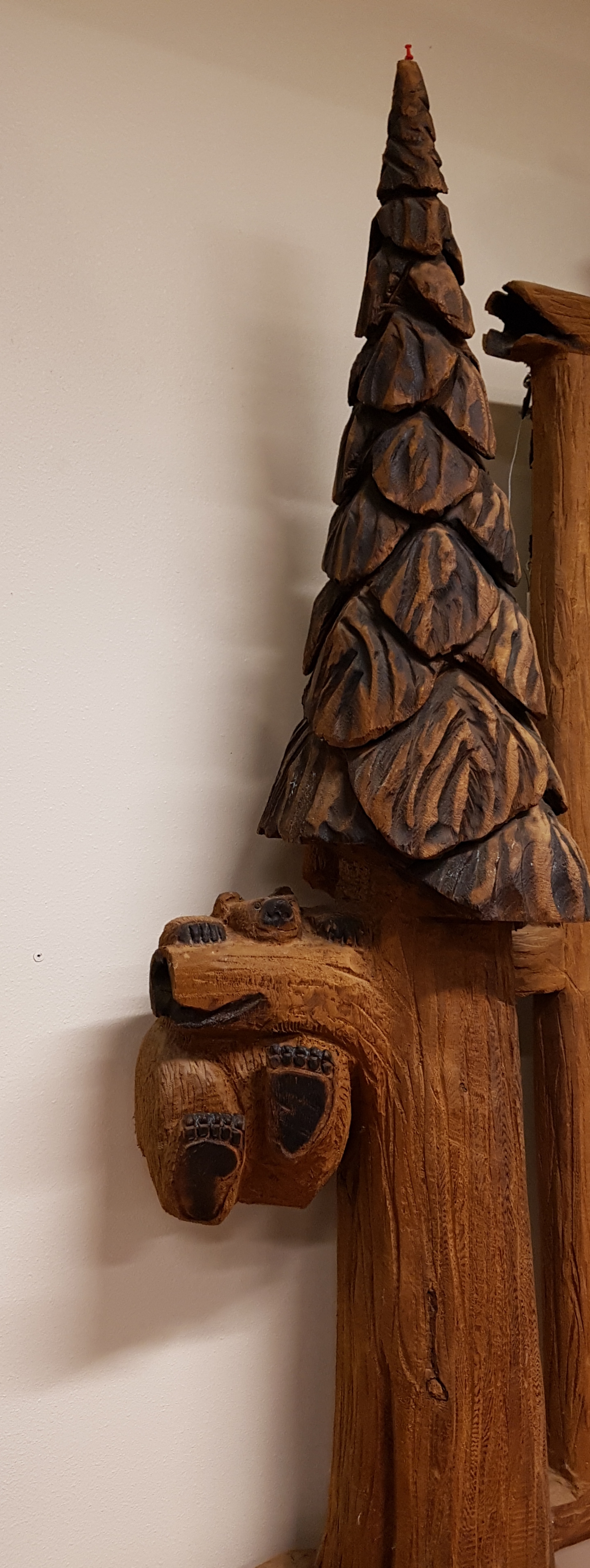
![]() [daily log: walking, 3km]
[daily log: walking, 3km]
Caveat: one who hamsts
I sometimes read a satirical linguistics blog called Speculative Grammarian. That blog often posts short, one-line jokes and such. Here are some that recently amused me.
What’s orange and sounds like a parrot? A carrot.
Did you hear about the kidnapping at the nursery? He woke up.
This paradoxical statement is false.
The cannibal became a missionary because “if you can’t eat ’em, join ’em!”
What’s brown and sticky? A stick
What did the fish say when he swam into a wall? Dam!
hamster (n) 1. one who hamsts. Ex.: “I’m gonna hamst you up.”
Caveat: Best of Arhet, Week 3
 Music to map by: Epsilon Minus, “Lost.”
Music to map by: Epsilon Minus, “Lost.”
Caveat: Poem #1305 “A metaphoric mess”
ㅁ I laid my metaphors to slowly dry. They dampened all the floor and stained my mind.
Caveat: Tree #419
Caveat: term of art
“Language is an art, like brewing or baking…. It certainly is not a true instinct, for every language has to be learnt.” – Charles Darwin
![]()
Caveat: Poem #1304 “A polaroid snapshot found in the ruins of Ur”
ㅁ Our knees were bent, our faces gazed, bemused. The table bore some cups, a bowl of fruit. Sumerian complaints escaped our mouths, but no one ever reached their statements' ends.
Caveat: Tree #418
Caveat: 음삭은 갈수록 줄고 말은 갈수록 는다
Here is an aphorism from my book of Korean aphorisms.
음삭은 갈수록 줄고 말은 갈수록 는다
eum.sik.eun gal.su.rok jul.go mal.eun gal.su.rok neun.da
food-TOPIC over-time decrease-CONJ word-TOPIC over-time increase-PRESENT
Food decreases over time and words increase over time.
This is a reference to the way that rumors are augmented as they are passed along person-to-person – unlike food, that is consumed as it is passed person-to-person. “Rumor grows as it goes.”
![]()
Caveat: Poem #1303 “The snow lacks conviction”
ㅁ The snow kept falling, failing, uselessly, barely blanking trees, melting on the ground.
Caveat: Tree #417
Caveat: a poke in the eye from the left
I had a kind of insight, recently, thinking about the Democratic primaries that are now playing out. Contrary to most of the pundits I’ve seen writing about it, I believe that Bernie Sanders has a very good chance of winning both the nomination and beating our current Space Emperor. Why? For the same reason The Oleaginous One himself was able to win in 2016.
People voted for Orange Julius Caesar not because of any of his policy proposals (which were both largely incoherent and have since been mostly ignored), but because it was a “poke in the eye” at the status quo. And in fact I think there are just as many people – if not more – on the left who think this same way, as compared to those on the right. They’re just fed up with the status quo and would like nothing more than to give the powers-that-be a good kick in the pants. Bernie can win because he’s a kind of “Drumpf of the left.” This is not true of any of the other Democrats running – not Bloombie, not Buttigieg, not even Warren.
You see, Sanders is basically a grumpy old socialist. He’s wholly authentic, and if his election wouldn’t be a good poke in the eye at the status quo, from the left… well, then nobody’s election would be.
What I’m listening to right now.
King Crimson, “The Court of the Crimson King.”
Lyrics
The rusted chains of prison moons
Are shattered by the sun
I walk a road horizons change
The tournament’s begun
The purple piper plays his tune
The choir softly sing
Three lullabies in an ancient tongue
For the court of the crimson king
The keeper of the city keys
Puts shutters on the dreams
I wait outside the pilgrim’s door
With insufficient schemes
The black queen chants the funeral march
The cracked brass bells will ring
To summon back the fire witch
To the court of the crimson king
The gardener plants an evergreen
Whilst trampling on a flower
I chase the wind of a prism ship
To taste the sweet and sour
The pattern juggler lifts his hand
The orchestra begin
As slowly turns the grinding wheel
In the court of the crimson king
On soft grey mornings widows cry
The wise men share a joke
I run to grasp divining signs
To satisfy the hoax
The yellow jester does not play
But gently pulls the strings
And smiles as the puppets dance
In the court of the crimson king
Caveat: Poem #1302 “The water pump”
ㅁ The pump: we could not repair. Another pump for water put in there... hard affair.
Caveat: Tree #416
Caveat: worth doing four times
I installed and uninstalled the new water pump (see yesterday’s blog entry) four times today, troubleshooting various leaks. On the forth install, it seems to be relatively leak-free, so Arthur and I decided to call it functional.
I enjoyed feeling competent to finally get it working.
But it was quite difficult and tiring, too. Out there in 32° weather banging on pipes:
1. Carry pump up to cistern shed.
2. Place pump on shelf. Attach hose, tighten clamps, repeat x 3 hoses. Bolt down pump. Test pump. Identify leaks.
3. Unbolt pump. Loosen clamps, remove hose, repeat x 3 hoses. Carry pump back down to workshop. Clean out threads, mess with fittings, reline all threads with teflon tape.
4. Go to step one.
Each loop takes about 2 hours.
![]()
Caveat: Poem #1301 “Rainforest celebration”
ㅁ There is water everywhere, abundant and redundant, in the air... don't despair.
Caveat: Tree #415
This tree has been featured here on this blog before. But I liked the green shade of the water in the rockpit pond.
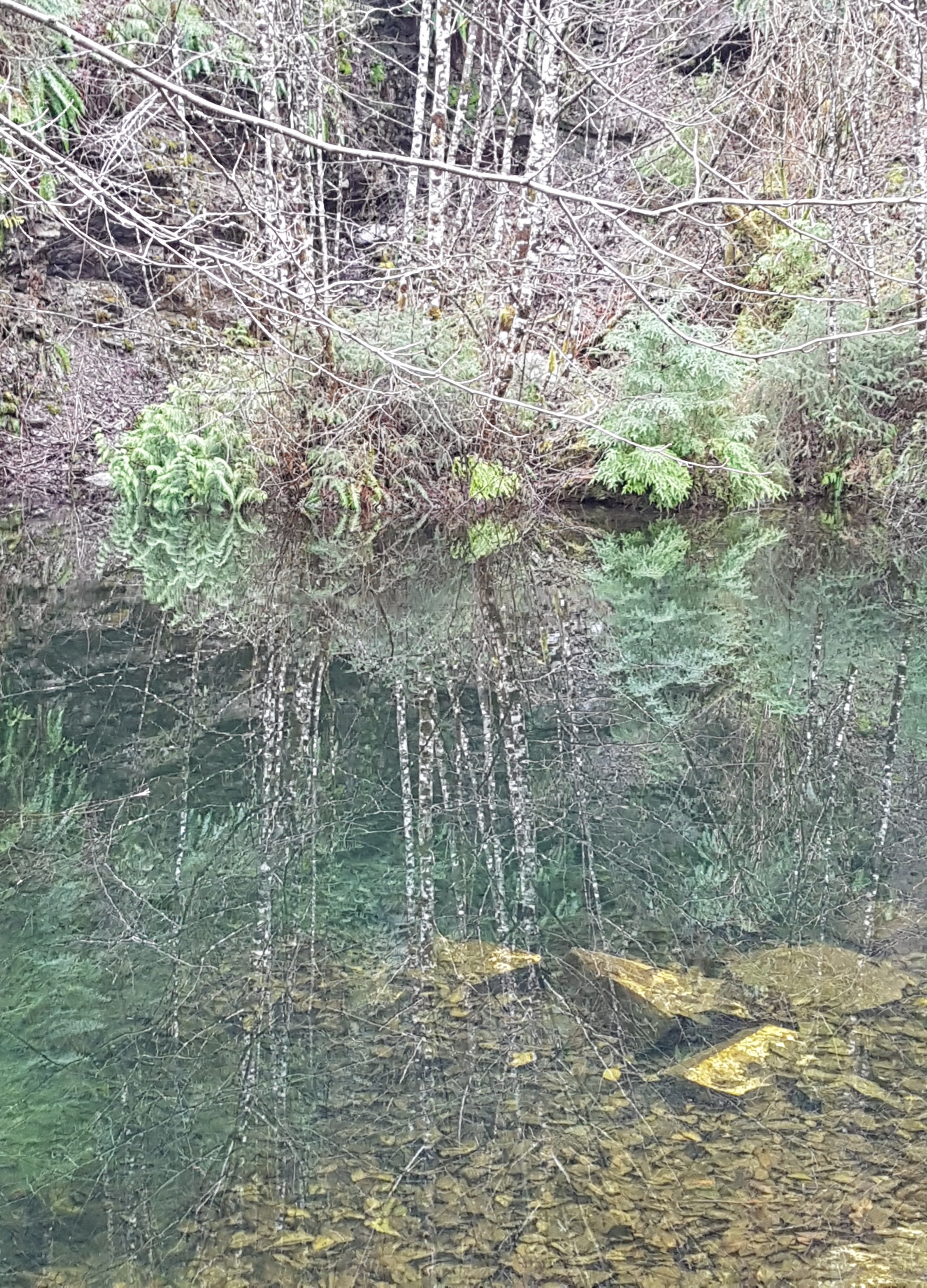
![]() [daily log: walking, 2km]
[daily log: walking, 2km]
Caveat: Unpumped
Early this morning, it seems, our water pump failed. This is the water pump that supplies the house with water pressure from the cistern, which catches rainwater from the hillside stream.
It’s not clear how or why it failed. It simply seems to have stopped being able to turn – the electric motor is only able to produce a kind of whining sounds as it attempts to spin its internal moving parts. Perhaps the motor itself is “frozen up” (i.e. not from cold – the temperatures are above freezing at the moment – but unable to move), perhaps there was some mechanical problem in the pump mechanism.
Regardless, this is a big issue.
Not as big as it could be, though. Firstly, Arthur has had, on hand, a “spare” pump.
So we spent the day first trying to diagnose the old pump’s problems, and subsequently trying to switch in the new pump. Both tasks proved frustrating.
The problem with the old pump is not clear. We were unable to even fully disassemble it. The pump housing is “stuck” to the motor, in some way we can’t figure out.
The new pump has its input and output holes positioned differently than on the old pump, which has the consequence that the pipe connections leading to it in the cistern shed need to be slightly rearranged. We ended up driving to town to the hardware store and getting some pieces, but even then, we weren’t really well-prepared for what we might need, and so we ended up improvising a bit to get all the pipes connected to the new pump. And then, the new pump was leaking. A lot. And it was getting dark.
Personally, taking the side of optimism, I think the problem is that we didn’t hook up our improvised pipe connections tightly enough, and we need take the new pump out, re-improvise, and reattach things more securely.
Arthur, for his part, taking the side of pessimism (of course), believes the pump housing on the new pump is cracked.
I’m going to try tackling my solution this morning. If that fails, and Arthur’s view prevails, we’re going to need a new pump. Updates will be forthcoming.
Here is the old pump, already removed from the cistern shed and waiting on the workbench in the shop for us to take on the challenge of disassembling it – which we have so far failed at.

Here is the new pump, already in place but not yet fully connected, while we sought out the pieces needed to get the pipes connected to it.

Meanwhile, we have improvised an alternate way to get water into the house. As was discussed on this blog last summer, we had a well put in (ostensibly for the western lot, #73, though there is some debate as to which side of the property line it ended up on). The well is not hooked up to Arthur’s house, on lot #74. But it’s there, and works, with a jury-rigged electrical supply going to the well controller hut (what we call the “doghouse” because of its size). So I ran a garden hose from the faucet I put in the western driveway across to a faucet in Arthur’s driveway. The well pressure comes through the hose, with both faucets open, and provides water pressure and well water to Arthur’s house. This temporary arrangement will work as long as the temperatures remain above freezing – which they currently have been.
Here is the hose off the well faucet. The “doghouse” is on the left, the western driveway’s faucet (which I installed last summer) is on the right.

Here is the hose connected to the faucet in Arthur’s driveway. I had to make a customized “female-female” length of hose to connect the hose to both faucets.

![]()
Caveat: Poem #1300 “Broken”
ㅁ The old device seemed broken, disarrayed. I was dismayed. Unspoken doubts appeared. No plans were made.
Caveat: Tree #414
Caveat: Chicken Little’s cognitive biases
I made up a kind of aphorism for myself. It goes: “It’s not that Chicken Little was wrong, but rather that he was overreacting.”
I suppose this summarizes my feeling about the current atmosphere of “climate change panic” permeating some social spheres. I believe 100% in anthropogenic climate change. I am not, by any stretch of the imagination, a climate change denier or skeptic. Nevertheless, believing that humans are changing the climate doesn’t (and shouldn’t) necessarily lead to immediate panic.
I think that in fact humans are pretty resourceful and ingenious. I expect that when climate-change crises occur, people will, for the most part, deal with them. I guess I’m an optimist, in some weird way. I think that even now, people are for the most part dealing with these things. But this quotidian “dealing with things” doesn’t make the news. Instead, the failures make the news. And that biases our view toward the negative and catastrophic aspects, and we miss the fact that most people, most places, are dealing with things. This is the same type of negative viewpoint bias that permeates discussion of issues like crime and terrorism.
Unrelatedly, here is a joke.
A man is consulting a doctor, at a very low quality, bureaucratic hospital. The doctor explains that he has bad news and good news. The man asks for the bad news first. The doctor says: “The bad news is that you’re dying of cancer.”
“Jeez. What’s the good news?” the man asks, alarmed.
The doctor sighs. “Around here, things take forever.”
![]()
Caveat: Poem #1299 “On the subject of pain”
ㅁ If hell is eternity, I would think my pains would shrink to bitty ants lost in a vast city.
Caveat: Tree #413
Caveat: documentation of my geofictions
Some of you might recall, I have another blog, besides this one. I maintain that blog mostly because this here blog is tied to my real-world identity, but I prefer to remain a little bit anonymous (obfuscated and pseudonymous more than truly anonymous) on the geofiction websites where I work and interact on what is really one of my main hobbies. I don’t post there very often – nothing close to daily, as I do here. A few times a month, on average. So this morning, I ended up writing a quite long entry on that other blog. It also has a number of included images, etc., so rather than reproduce it here (which would be complicated because my two blog platforms are truly independent, and I’ve got them configured quite differently), I’ll just give you a link:
Documentation of my geofictions, at blog.geofictician.net. Consider this to be my blog-post of the day, but off over on that other blog.
[UPDATE: On reconsideration, I’ll directly cross-post (cut-paste) that entry here following, for posterity’s sake.]
I was inspired by a recent bit of “OOC documentation” by the OGF user donnamaw (here) to discuss, if only in outline form, the real-life origin stories of my various geofictions. How and when did I invent, in my imagination, the various places that I have drawn (or attempted to draw) maps of? The order in which these places were drawn or introduced to geofictional spaces is not the order in which my mind created them. Here I’ll try to present them in the order in which they were first imagined.
Rahet.
Rahet is a planet. It has four main continents, which bear a reliable suffix meaning “continent,” -eye (pronounced as IPA /eje/). The history of Rahet is one of human colonists settling a desert planet and terraforming it over 1000’s of years. The terraforming process is frequently interrupted by squabbles among the factions that emerge, but nothing is stable, and few nations and groupings last more than a few generations. The technological level is high but unequally distributed – you have spaceships and artificial intelligent machines coexisting with spears and chariots. There is a particular faction, led by a machine named “Zon,” which keeps the terraforming project more-or-less “on track,” but often at the cost of moral clarity. All of this was developed in my imagination beginning around the age of 10. I was a bit precocious as a child, and by 10 I had read the Lord of the Rings, the Dune books by Frank Herbert, and numerous other pulp sci-fi works by authors such as Andre Norton, Alan Dean Foster, and Harry Harrison, among others. These types of works influenced my thinking about Rahet, and by age 12 or so I had a quite clear picture of the planet’s historical trajectory and some of the key elements of the culture. I began drawing maps early. Most were focused on the continent called Tsiqeye, which is where the earliest settlements were established, around a rock formation called Redithk Illim (which resembled in my imagination Wyoming’s Devil’s Tower, but much larger). I remember drawing out an outline of the continent with coastlines and major rivers at around age 11, taking it down to the photocopy store (such as life before scanners and cheap, high quality printers), and making a hundred “blanks.” I numbered them at 50 year intervals (thus covering 5000 years of history), and then drawing a series of historical maps for the nation-states, tribes, empires and other factions playing out Rahet’s complicated and intricate history. I wish I still had those maps. A few years ago I uploaded Rahet to my new geofictician server, but later deleted it, deciding I wasn’t ready to dedicate an entire server to the project. Here is a (sadly blurry) screenshot from that time when it was uploaded.
Rahet has remained a constant in my imagination ever since my pre-adolescent years. Note that the name is an anagram of “Earth.” Here is a map I found just recently, of the Rahet continent called Preye. I believe I was in high school when I drew this (early 1980s).
Ta Hre.
Ta Hre is another planet that was created around the same time as Rahet. It exists in the same universe, but rather than being an earth-like, terraformed planet it’s an airless moon, with people living in pressurized “cities” laid down in craters and canyons in the moon’s surface. I never really attempted to draw maps of the planet as whole, but I did draw many of these enclosed cities – often not just standard airplane-view maps, but also elevation diagrams of the various levels of the cities, since they were fully three-dimensional. Ta Hre is another anagram of “Earth,” of course.
Mahhal.
Mahhal is a few years younger than Rahet. I created it in high school. In fact, it started as two separate planets/cultures that I merged into one when I was in college. The first, which gave the name of the planet, Mahhal, was created as a kind of “antagonist” to Rahet. I had started trying to write a novel about Rahet, and I needed some “bad guys” so the novel would have a strong life-or-death conflict. I created the Mahhalians as an alien group who arrived at Rahet at some point and attempted to conquer it. They mostly failed, but they maintain outposts and fight occasional skirmishes with the Zon faction which works to protect Rahet’s independence. Over time, I created the Mahhalians’ background, including a conlang and ideas about their culture and planet. They are a kind of dystopian theocracy, but very high tech. They are humanoid (and in my never-completed novel, I leave as a kind of open mystery whether the Mahhalians are mutant humans or an unrelated species). They live on a world that is currently in an “ice age,” thus there are permanent ice caps on both poles and extending to about 40° latitude. Only the equatorial zones are habitable, but the Mahhalians have built vast, high-density cities, often protected by strings of giant domes across the landscape. The other geofiction, created at the same time, I called Pas Daons. It wasn’t a whole planet, but a country. In particular, I created the cities called Derindonderak and Askendom. In its first iteration, Pas Daons wasn’t a high tech or alien society. It was just a kind of alternate Earth, such as would fit in well on OGF today. I drew a detailed “city atlas” on paper of the city Derindonderak, and I still have clear visuals of the city’s layout, its topography, street plan, etc. However, by my second year in college, I’d “borrowed” Pas Daons to give more detail to my Mahhalians, and thus Derindonderak became the commericial capital of Mahhal, and I came to see Pas Daons as a “historical snapshot” of the more advanced Mahhalians. Rahet/Mahhal and the novel that was set there were abandoned when I moved to Mexico, and lay dormant until I attempted to resurrect Mahhal as an OGF archipelago in 2015. I had to make a lot of compromises with respect to my original vision for the Mahhalians – they had to be demoted from high tech, planet-controlling aliens to mediocre humans confined to a high-latitude archipelago. They retained their dystopian theocracy and conlang, however. At this point, I consider my effort to port Mahhal into OGF to be an abject failure. I became dissatisfied with the compromises I felt I’d been forced to make, and my hope to recreate the seething metropolis of Derindonderak (so vivid in my imagination) was disappointing. I retain a “rump state” version of Mahhal in OGF mostly to justify the existence of Tárrases (q.v. below) – and because I just like the name. It’s my oldest and most closely cherished imaginary name. Here is Mahhal as currently drawn on OGF (and link to boundary relation):
Rasf-sayan.
Rasf-sayan is another geofiction I developed in high school. In its first incarnation, it was a parallel-earth Caribbean island with a conlang meant to resemble a native American language. I modeled it socially and culturally on Haiti. I didn’t start a novel about Rasf-sayan, rather, I started an epic poem about a character named Aochra. He is fighting corruption and trying to save hopeless lives mired in poverty. He’s kind of a cross between “Blade” and Bob Marley. I drew lots of detailed paper maps of Rasf-sayan in high school, mostly focused on the main city, Poer-rasf-oa. At some point in college, I hijacked Rasf-sayan for my Rahet project. The hijacking was thorough and I don’t regret it. Rasf-sayan became an island on Rahet, in the sea between the continents of Preye and Sekieye. Rasf-sayan is mired in poverty because it is one of the pockets of Rahet controlled by the ruthless and inhumane Mahhalians. They have one of their space elevators anchored on the island, that allows them easy access to and from the planet. In the Rahet novel, the main character is trying to reach Rasf-sayan, because he needs to get off-planet. That’s his McGuffin that drives the plot. He meets Aochra, as a supporting character, and who is double agent – nominally working for the Mahhalians, but secretly allied with the Zon. Ultimately, any geofiction I draw of Rasf-sayan will be located and integrated to Rahet. Here is Rasf-sayan on Arhet, as of right now.
It’s barely started. But I retained it when I deleted the rest of Rahet and made it into Arhet (see what I did there?), because I thought I’d work on it at some point.
Ardisphere.
Ardisphere had a strange genesis. There is a novel by Vladimir Nabokov, entitled Ada. I believe there is a bit of geofiction (or at the least, alt-history) in that novel, since the Russians seem to control North America. An important setting in that novel is a place called Ardis Hall. I must acknowledge that that is the origin of the name Ardisphere. But… the imaginary country came after the name, by a few years. At first, I remember using the name Ardisphere for an early website I developed, as a kind of alternate identity where I would present my geofiction ideas or half-made novels. I made my first website in late 1994 (the web was only 2 years old at that time), on a thing called geocities – an early free website hosting service. I had a “professional” site that I used for my work at that time, and personal site, that was called Ardisphere. It was only a few years later, after I allowed the Ardisphere website to pass into internet history, that I started using the same name for an imaginary country. I had started a novel in which a group of refugees from earth, traveling in a sub-light-speed “generation ship,” arrive in another star-system with an earth-like planet, inhabited by a alien race that has a technological level similar to humanity’s. As refugees, the aliens decide to grant to the humans a few thousand square kilometers of mostly desert land they aren’t much using, to build their own refugee country. I drew a detailed map of Ardisphere. Since many of the refugees were from Latin America, most of the cities ended up with Spanish names. Hence Villa Constitución, Cerro y Casa, Puerto Desolado, El Cabo, Palmeras Grises. The names were such as I imagined a modern group of Spanish-speakers might apply to the alien planet they were colonizing while focusing on the ideals of their “new earth.” The novel was about a point in time about 100 years after the building of the settlement, at a point when aliens and humans have started to coexist in a hybrid culture. The novel, like all my novels, never reached any kind of finished state, but it included “Clarkean” magic (i.e. “any sufficiently high technology is indistinguishable from magic), criminal gangs from poor neighborhoods (the slums of VC), aliens engaging in conspiracies to control the humans they’ve welcomed to their planet, and humans doing the same in return, etc. The novel also has the seed of what later became the Cartographers and Cyclopedians – freemason-like secret societies that play a large role in the evolution of life in the country. Interestingly, in the original map of the Ardisphere, it was a peninsula. When I first stumbled across OGF in early 2014 and made an account, I took the only green country I saw at that time, AR025. That wasn’t a peninsula. But I’d already decided to make Ardisphere my first OGF creation. That was partly because I felt that, among all my sci-fi geofictions, it would be the easiest to adapt to the OGF “real world” style setting. I had to rearrange the geography completely to fit the peninsular Ardisphere of the novel into the oddly shaped, mostly land-locked territory in western Archanta. But I consider the adaptation to be successful: I cannot visualize Ardisphere at all in my mind now, without calling to mind what’s become the iconic shape of AR025. Since aliens weren’t allowed on OGF, and since I was living in Korea at the time, I made a spur-of-the-moment decision that my Ardispherian aliens would be Koreans. I don’t regret my decision. The Latin/Korean hybrid that OGF Ardisphere became is intriguing and has a lot of interesting cultural details. I am currently undecided as to the fate of the OGF version of the Ardisphere. One part of me still eagerly wants to complete (or more accurately, restart) the novel set there, with changes to “fit” the OGF setting. I see it as a kind of thriller/detective novel set mostly in VC, with travels to other OGF places – Jeongto, Tárrases, Ohunkagan, Gobras City… Further, It was only after embedding Ardisphere in OGF that I began imagining my characters might become aware they were in a geofiction, and begin manipulating it. This has given a great deal of new interest and impetus to whatever plot I finally come up with. Another part of me wants to restore the aliens and the high tech magic and re-draw Ardisphere on its own server, unconstrained by OGF’s strictures about verisimilitude. I also feel like removing Ardisphere from OGF because I’ve been so inactive with mapping there, and I feel it is not fair for me to occupy territory on OGF that I’m not actively working on. Here is Ardisphere as currently drawn on OGF (and link to boundary relation):
Lekista.
I started a novel in around 2002 which was set in a steampunk universe, but in which the main character was modeled on Augusto Pinochet, of all people. I had been reading Pinochet’s autobiography, and I had had this thought: “That is a seriously sociopathic dude. There needs to be a fictional version of him.” So the story was, roughly, parallel to Pinochet’s life, and written from his perspective, but through the book you realize that the protagonist is a brutal dictator and he’s not a reliable narrator. It’s one of those “psychopath as protagonist” books. I wanted to create a parallel Chile, as a place where the novel takes place, but I wanted to change the details enough that it wasn’t recognizable as Chile. So I made it a steampunk setting, and I created a somewhat alien culture. Instead of creating a conlang or using Spanish, as in Chile, I made what still feels like an inspired decision to “hint” at a conlang, but not bother with actually creating it. Thus all the place names in Lekista are “translated” into English. You have the country’s capital, Holy Brighthorse. Other cities such as Castlepass, Feast Mountain, Dogschild, etc. The names lend a bit of a native American feel to the story and setting, since a similar thing occurred with a lot of native names, especially on the Great Plains: Sitting Bull, Red Lake, Crazy Horse, Moosejaw, etc. Eventually I gave up on the novel. I found fake-Pinochet’s mind too uncomfortable to inhabit. But I was quite pleased with Lekista, and drew many paper maps of the country and its cities. In 2013 I drew a map, just a sketch, where Lekista was integrated to Rahet. So as of the present moment, Lekista is just one of the many hundreds or even thousands of polities that exist on Rahet. I think one of the things I like about Rahet is that its diversity allows it to “host” so many of my formerly independent geofictions. Here is Lekista in JOSM.
Senhar.
At some point while developing Ardisphere in 2015, I began thinking about Ardispherian religion. In the original, novelistic Ardisphere, religion and strange beliefs about psyche and the paranormal play a major role. But it’s largely “alien” and tied in with the aliens who intermingle in Ardispherian society. That was not an option for OGF Ardisphere. So since the aliens had become Koreans, it seemed logical for the alien religion to become … Buddhism. I created Gautamism as the OGF version of Buddhism, and made it the main religion in Ardisphere. Bear in mind that since the late 1990s, I myself have been a semi-practicing Buddhist, so this is not a stretch for me. In OGF-world, though, names must be changed. And source places, too. I invented Senhar to be the home of OGF Buddhism, and began drawing maps of it offline. It is meant to be an equatorial island nation, modeled on Sri Lanka (not the real home of Buddhism on earth, but an important nation for the historical development of the religion nonetheless). But in the center of the large island I placed an extreme highlands (over 5000m), which would allow me to also include an OGF Tibet. Thus Senhar is a Sri Lanka / Tibet hybrid country. Since I have zero competence in the Tibetan and Sinhalese languages, I decided to go the conlang route, and invented a Senharian language that would be a bit based on Korean (which I do know) but written using Tibetan characters. Here is a screenshot of Senhar from JOSM, which is where it exists for now, with incomplete contour work.
If anyone ever creates an OGF India, it would be my intention to petition admin, at that time, to allow me to place the island of Senhar off that country’s coast.
Tárrases.
I created Tárrases exclusively because I felt I needed to try to make a microstate where I could focus and develop my mapping skills using JOSM and OGF. I wanted something I actually could “complete” in a reasonable amount of time. Secondarily, I wanted a place where I could allow my two main OGF societies to “meet.” Hence Tárrases was inspired by Spanish (Ardispherian) and Mahhalian cultures. I placed it as a libertarian enclave in dictatorial and theocratic Mahhal – a kind of Macau or Hong Kong to a Mahhalian China, in a geopolitical sense. I believe Tárrases is my finest and best-developed geofiction to date – exactly as it was intended. I’m very proud of it. As I was mapping it, I thought a lot about what kind of culture it was. I wanted something with maximal contrast to Mahhal’s rigidity, so I settled on a kind of libertarian-anarchist state. In fact, I was inspired by Tamarindia, which I pointed to at the beginning of this write-up. Tárrases was founded by pirates, who “stole” a Castellanese colony by making an unholy alliance with the Mahhalian aristocracy. They went “legit” and the Carapreta Dynasty, founded by the pirate Omar, has survived for over 200 years. Here is Tárrases as currently drawn on OGF (and link to boundary relation):
Kshang.
I still believe in this project, but I’ve negected it hugely. I would someday hope to resurrect it in a more hospitable setting than hapless Rhododactylia. The
Kshang are imagined as a parallel to one of the many ethnic groups in South Africa (since I’d decided somewhat arbitrarily that Rhododactylia was a kind of OGF South Africa, maybe). I think in fact the Kshang began as a conlang, and the geofiction came later. It’s possible that I had a conlang that looked like Kshang even in high school. And I remember sketching maps for them, too, but they weren’t very detailed. It was meant to be a pre-modern society. But I know Kbloniksbhag (Bone House) was the “capital,” such as it was. I spent more time developing the Kshang religion and culture, and thinking about life in a traditional Kshang village. I think my effort to place the Kshang as a major ethnic group in Rhododactylia was a failure – mostly because I lost hope of that country ever being in any way a coherent geofiction at all. They need a home of their own, a little OGF Botswana or something. Here is Kshang as currently drawn on OGF (and link to boundary relation):
Bofobunda.
I invented Bofobunda in 2016 (I think) at a point in time when I was thinking of a way to make West Commonia culturally interesting, in the way Gobrassanya is interesting. I had orchestrated the “divorce” of West Commonia from Commonia, and so I had intended to place some mapping there. I wanted a stand-alone project, so I created the Bofobundans. I got distracted by their language and culture, something vaguely southeast Asian but with a conlang written with the Farsi (modified Arabic) script. So I never uploaded any of the mapping to West Commonia. And I’m glad I didn’t – someone would have surely destroyed it beyond recognition by now. I “rescued” the Bofobundan culture from obscurity by placing them as a small minority in Ardisphere, with a concentration of population at the city of Lagartopolis, where they have a large, famous mosque. I would like to work on that more. Their home country remains unmapped. Here is the capital of Bofobundah, the city of Zhebeyem. This was my first experiment with contours and maperitive – a largely failed experiment.
Makaska.
Makaska is my newest OGF project. Currently, I view its success as second only to Tárrases, and on a much larger scale. Unlike Tárrases, it’s far from finished. Like Tárrases, I think Makaska has been successful partly because I created it for OGF. It’s OGF-specific, and thus I don’t feel any regrets about editing out any formerly existing inverisimilitudinous elements, due to OGF’s rules. Once I’d kicked off the FSA project, I began thinking about how I could participate by taking on my own state, on the principle of “lead by example.” I wanted to make an exemplar FSA state. My thoughts turned to my years living in Minnesota. I had studied the Dakota language in college, there, and since I wanted my FSA state to have a strong “native” presence, and I wanted it to feel authentic, an OGF Minnesota seemed logical. I pulled out my trusty English-Dakota dictionary from college, and got started making up names. So far, I’m happy with it. It’s a work-in-progress, and is my main “active” geofiction, right now. Here is Makaska as currently drawn on OGF (and link to boundary relation):
Deadlands.
The Deadlands is not the same as the other geofiction projects, above. The background is that for a while while living in Korea, I resurrected an old habit I had from the late 1980s – I started playing MUDs (text-based computer role-playing games). But when I started maintaining my own Linux server in 2016, I went further. I decided I should build my own MUD. So I started to. It’s currently offline, regrettably. It’s called Hellbridge, and it’s a post-apocalyptic/fantasy hybrid that takes place in an inverisimilitudinous setting called The Deadlands. Here is a screenshot of the Hellbridge MUD login.
My intention was to actively integrate the OSM-style slippy map with the game, so that players could follow their progress in the game world with a marker on the website map. So I have been experimenting with non-standard tagging of nodes that I could tie into the MUD database through some kind of customized database procedure, such that a character’s “current location” could be tied to a pin on the map, google-maps style. Here is a map window (leaflet) with a test marker, showing the map-in-progress of the village of Goodgrove – intended to be one of the “starter villages” for new characters exploring the Hellbridge universe.
I don’t know what made me write all this, just now. Perhaps I grew tired of typing out the same explanations over and over on the OGFC Discord, or in conversations in the OGF Forums and diaries. So now I can just point people here. I might add to this write up with more detail over time. Music to do meta-geofiction to:

